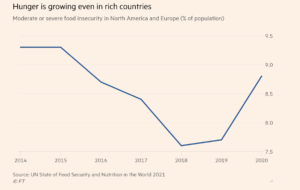Bloomberg's Leah Nylen reported Thursday that "a Colorado judge issued an order temporarily blocking the proposed $25 billion merger of Kroger Co. and Albertsons Cos., which has been challenged by…
Chicken Prices Soar, as Tyson Projects Higher Meat Costs Ahead, and Two Rivals Combine
Wall Street Journal writer Jacob Bunge reported on Monday that, “Tyson Foods Inc. projected higher meat costs ahead, as the meat company seeks to pass along elevated prices for animal feed, increased wages and ongoing pandemic expenses to restaurants and supermarkets.
‘We’ve seen unprecedented and accelerating inflation and we’re trying to catch up with that,’ said Tyson Chief Executive Donnie King, on a conference call with reporters.
“U.S. restaurants’ intense demand for chicken breasts and wings is at times outstripping supplies, industry executives have said. Fast-food chains have been battling to launch new chicken sandwiches, while chicken wings have played a leading role in to-go restaurant sales.”
Mr. Bunge pointed out that, “Rising labor costs along with elevated prices for packaging, transport and grain—typically the biggest expense in raising livestock and poultry—are pushing Tyson to raise prices the company charges supermarkets and restaurants, executives said.”
And Reuters writers Tom Polansek and Praveen Paramasivam reported on Monday that,
Tyson Foods Inc cannot increase prices for chicken and prepared foods fast enough to keep pace with rising costs for raw materials like grain, Chief Executive Donnie King said on Monday, after the company reported higher-than-expected quarterly earnings.
The Reuters article stated that, “Tyson has increased prices for restaurant customers to offset inflation and plans to raise retail prices on Sept. 5, King said on a conference call with analysts. More increases are planned, he said.”
Also on Monday, Associated Press writers Dee-Ann Durbin and Michelle Chapman reported that, “With the price of chicken soaring, the third-largest poultry producer in the U.S. is being bought for $4.53 billion.
“Cargill and Continental Grain have formed a joint venture to acquire Sanderson Farms, paying $203 per share in cash for a company that last year processed more than 4.8 billion pounds of meat.”
The AP article stated that, “The deal comes as chicken prices are surging. Wholesale chicken breast prices have been at or above $1.80 per pound since mid-April, a seven-year high, according to the Livestock Marketing Information Center. Last year at this time, they were $1.13 per pound.”
Monday’s article added that, “The price increases have been compounded by demand from major restaurant chains. McDonald’s Corp., Popeyes Louisiana Kitchen Inc., Wendy’s Co. and Burger King have all recently introduced new variations of chicken sandwiches. McDonald’s cited chicken sandwiches, as well as a chicken McNugget meal promotion with the boy band BTS, for its better-than-expected second quarter sales.
“Wholesale chicken wing prices have been above $3 per pound since April, well above the five-year average of $1.75 per pound.”
In more detailed reporting on the Cargill, Continental acquisition of Sanderson Farms, Financial Times writer James Fontanella-Khan explained on Monday that, “Cargill and Continental Grain Company have jointly agreed to acquire Sanderson Farms, valuing the US poultry producer at $4.53bn at a time when demand for chicken meat has been soaring.
“As part of the transaction, Sanderson Farms will combine with Wayne Farms, a subsidiary of investment group Continental Grain, to form a new privately held poultry business.”
The FT article added that, “Cargill and Continental Grain will control the newly combined company through a joint venture owned in equal parts, said people briefed on the matter.
“The deal will allow Cargill to expand its international poultry business in the US, which is one of the world’s fastest-growing markets.”
Monday’s article noted that, “The new company, which will be led by Wayne Farms chief executive Clint Rivers, will produce about 15 per cent of US poultry meat, according to Watt Poultry USA.”
DOJ shld make sure merger doesnt frustrate competition/facilitate anticompetitive practices/harm consumers Poultry industry has recently been investigated for price fixing so we need thorough review
— ChuckGrassley (@ChuckGrassley) August 9, 2021
Amid the expectation of higher prices for meat, Emiko Terazono and Davide Ghiglione reported this week at The Financial Times Online that, “Across Europe and North America, the number of people to have gone hungry increased for the first time since the UN started collecting data in 2014, according to recently published figures. Nearly 9 per cent of people were moderately or severely food insecure in 2020, compared with 7.7 per cent the previous year.”
The FT article stated that, “In the US, food banks were serving 55 per cent more people than before the pandemic, according to Feeding America, which runs a nationwide network of food banks. It said 45m people experienced food insecurity last year.

“While the number was lower than after the financial crisis in 2008, when food insecurity affected 50m people, food price inflation was becoming more of a concern, said Craig Gundersen, professor of agricultural and consumer economics at the University of Illinois.”





